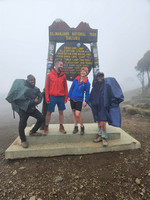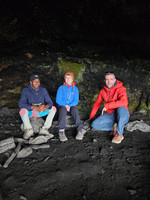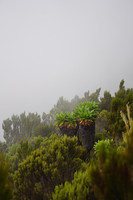
Summiting Kilimanjaro via the Machame Route over 6 days, 5 nights
Aug 13
12 min read
1
29
2

In March 2023, we flew to Tanzania to take on the challenge of summiting Africa's highest peak. As we were both pretty experienced hikers, we opted for one of the shortest routes up the mountain, which was the Machame route over 6 days & 5 nights (summiting on the morning of day 5).
We did this with Local Moshi Adventures - a local guiding company who I would highly recommend
The excursion cost roughly $1800pp excluding our flights (this did not include the tips for the guides but I will cover that topic later).
How To Get There -
The starting point for most of the routes to the summit is from the town of Moshi in Tanzania. The nearest international airports would be Nairobi, Kenya or Dar es Salam. The flight is really small with only about 12 people on it, but it is pretty magnificent to have a birds eye view over the African plains. You can also get to Moshi by bus from these areas if you would prefer this to flying.
Day by Day on Kilimanjaro
Day 1 Machame Gate to Machame Camp (3,000m) 11km 1000m
Day 2 Machame Camp to Shira Cave Camp (3,850m) 5km 850m
Day 3 Shira Cave to Lava Tower to Barranco (3,950m) 10km 780m
Day 4 Barranco Camp to Barafu Camp (4,673m) 10km 700m
Day 5 Barafu Camp to Summit to Mweka (3,100m) 13km 1200m
Day 6 Mweka Camp to Mweka Gate (1,640m) 10km 1500m loss
Day 1 - 11km - Machame Gate to Machame Camp - 5 hours
We spent the night before the trek at a local hotel in Moshi. In the morning our porters came to collect us at the hotel - we were assigned twelve porters for our group of just two - which at first seemed quite extreme but each of the men had their own job and was a pleasure the have along on the journey with us. We drove to Machame gate, which is roughly 1-2 hours away, to register and get our bags checked and weighed before the hike. Your bag must not weigh any more than 15kg, and items such as plastic bags/ bottles or any alcoholic drinks are not allowed into the park. We then set off through dense rainforests rich in tall trees and various plant life. We were lucky enough to spot some monkeys playing in the trees above us but we also get caught in a thunderstorm which made the forest charismatic. We stopped for lunch half way which was a packed lunch that we had picked up from the gate. On arrival at Machame Camp, we were showered in petals and a warm welcome from the porters who are always ready with a song and a dance. This was the first of us seeing our camping setup and it was incredible - for those of us who are used to wild camping, it was maybe a little too much luxury than we expected - we had a toilet tent, table and chairs to eat on and were given a basin of warm water in the evening and morning to wash in. All of these are luxuries that we usually go without if we are camping at home but I guess it was special touches to provide people with some home comforts. We were served hot drinks (my favourite was Milo) and popcorn whilst we spent some time taking in the views from the camp. We had a three course meal for dinner before settling down to watch the stars for the evening.
Day 2 - 9km - Machame Camp to Shira Cave Camp - 5 hours
After a hearty breakfast the day starts off with a pretty steep incline that takes you through the rainforest, once you climb your way to above the treeline don't forget to stop to look back for some epic views. Shortly after the steep rainforest section we stopped for lunch - it was a rather busy spot with most of the other groups also stopping here - we had a packed lunch but some of the teams were setting up full tents with tables and chairs for a full sit down lunch - I personally would not have wanted this every day. This is where we experienced our first long drop toilet and some curious ravens who had came to see if we had left any crumbs. As the day continues, the setting around you transforms from leafy rainforests into something that looks like a scene from Jurassic park, with incredibly interesting rock formations. The terrain is rocky and there are some streams and water sources that you may need to navigate - depending on the weather. Upon reaching Shira Cave Camp, our guides gave us the opportunity to rest in our tents for a while then if we wanted to they would take up to hike a bit further to see the Shira Cave and we were keen to explore a bit more. Shira Cave is a natural cave formation which was used as accommodation in the early days of climbing Kilimanjaro, and although nobody is allowed to sleep in it these days, we did spot a cute little mouse which has made the cave its home. There are some cool rock formations up here and you can climb up to give yourself a birds eye view across the campsite. This was where I noticed an extreme temperature drop in the evenings and some tents even had a coating of frost that had formed during the night.
Day 3 - 12km - Shira Cave Camp to Lava Tower to Barranco Camp - 7.5 hours
On day 3 we climb high and sleep low. This was all about getting our bodies acclimatised to the altitude so we ascended around 900m to Lava Tower which was at a height of 4,600m, followed by a descent of 800m to sleep low at Barranco camp (3,900m).
As we set off from Shira Cave camp we had beautiful weather and could even see Meru Peak peeking through the clouds. As you walk on through the alpine desert there is no longer much plant life to view but instead you will see a vast amount of people making their way across the plain to reach Lava Tower - giving the impression of little ants in the distance. Kilimanjaro clearly came into view for us here, and we could see the vast snowy silhouette ahead.
Lunch is at Lava Tower camp which is a 300m high volcanic plug on the mountain - it is certainly a sight to behold. This was the only lunch spot that our porters insisted on building up our tent for us to eat our lunch in, and to rest to acclimatise for a few hours before continuing the journey down. As much as a rest was appealing, we are only here once so we took a short walk to explore and take in the views - there were loads of cool rocks to climb up to sit on and take it all in.
After a few hours we continued the journey on to Barranco camp. This part of the hike felt like we were in a movie as we walked past giant groundsel trees, which are actually a type of daisy the size of a tree. Fun fact - this is the only place in the world where you can see them!
Barranco camp is definitely the busiest camp of them all, as it is the point where multiple trekking routes meet. You will be greeted by the site of a vast amount of coloured tents against the grey rocky backdrop. There are a lot more people here than the other camps, and it can be quite loud during the night and in the early hours of the morning - I'd advise ear plugs if you want a peaceful nights sleep.
Day 4 - 10km - Barranco to Barafu (Base Camp) - 5.5 hours
We woke up early and after a good breakfast, we set off from camp to beat the crowds on the Barranco wall. Because there are so many people leaving from the campsite, this point can get quite crowded and with the narrow paths there isn't much opportunity to over take. You ascend Barranco wall which is steep and rocky and at some points is a hands on scramble. I had so much fun doing this section and have complete admiration for the porters who do this whilst carrying all the equipment - sometimes even balanced on their heads. You pass by the famous kissing wall - a narrow point where you have to press by the rocks. This wasn't actually as bad as people make out (see pictures), just take care and you will be fine. I think our guide noticed how much we both enjoyed the scrambling and took us up an alternative path to reach the plateau. We continued on via a descent through Karanga valley and Karanga camp where many groups will stop for the night, before we finally reached Barafu camp which would be our base camp before the summit push the next morning. You could feel the excitement throughout the campsite and we were greeted to an incredible cloud inversion against the backdrop of Kilimanjaro. We indulged in an early dinner and tried to get some sleep as we would be setting off during the night to hit the summit.
I was equally pleasantly surprised and shocked to discover that Barafu camp had Wifi - with only the first 30 minutes being free.
Day 5 - 20km - Barafu to Summit - Barafu to Mweka camp - 10 hours 45 mins
After a few hours sleep, we got ready to set off from base camp at 12.30am to ascend 1,255m in a mammoth push up the mountain. We were going from 4640m at Barafu Camp to 5895m at Uhuru peak. The initial ascent from the camp up to Stella point was very slow and steep. We could see a trail of torch light from all the other hikers in front of us who had left earlier. I'd say this part was more of a mental struggle as it felt like it went on forever. We were advised to set off wearing all of our layers when we left camp, but this didn't work for me as as soon as we started the ascent I was sweating, so I had to stop to take them off again - which I'm glad I did or else I wouldn't have been able to put any more layers on at the summit to keep warm and I'd have been cold and wet from sweating. We hike at a relatively fast pace and moved pretty rapidly up towards Stella point, passing most of the groups who left before us. Neither of us had had a problem with altitude until this point - I felt overly sleepy and kept wanting to just stop to take a nap whereas Tom was seeing patterns on the rocks and got quite slow and delirious. Nothing too extreme but definitely noticeable. We stopped for a short rest at Stella Point where we had a warm drink. We could see the summit from here so that definitely gave us some motivation and energy to push on and get there. We hit the summit at 6am, just as the sun was coming up and we got the witness sunrise on Africa's highest peak. Luckily we were one of the first groups at the summit and got to experience it before the crowds came and it started to get busy. Take it all in here! As much as you can, the glacier, the summit, the views, the sunrise and the feeling of accomplishment!! You did it!!
The summit is bitterly cold and after taking my glove off to take some pictures, I couldn't feel my fingers. As incredible as it is you can't hang around for too long on the summit due to a mix of the altitude and the coldness, so we begun the long descent. Our guides took us a different way which was mainly scree and was a bit of a nightmare on tired legs. We got back to Barafu camp at 8am to have some much needed food and a few hours rest before continuing a further 10km down to Mweka Camp for the night where we had a celebration song and dance with our porters. I hadn't noticed many bugs on the trip but if you were going to get bitten, I think it would be here as the camp is nestled in amongst the trees.
Day 6 - 10km - Mweka Camp - Mweka Gate - 2 hours
We slept for 10 hours!! Which must have been very much needed after the previous days hike. The final leg of our journey was to descend from Mweka Camp to Mweka Gate. A simple walk in good spirits, passing back through the dense rainforest where we were once again lucky to spot lots of monkeys playing in the tree tops. We caught one final glimpse of Kilimanjaro through the trees and it was time to say goodbye. Upon reaching the final gate you must register your completion and check out with the rangers. You can enjoy a well deserved beer from the bar here. Once back at the hotel we were presented a certificate and some keepsakes from our tour group.
TOP TIPS & HELPFUL INFORMATION
Food - there will be an assigned chef that brings fresh ingredients up the mountain to cook you breakfast, lunch and dinner. The three meals tended to vary from day to day but consisted of things like
Breakfast: porridge, fruits, toast & spread, eggs, sausages, hot drinks
Lunch: packed lunches for the first few days, then pastas, toasties, salads, soup
Dinner: stews, chicken, meat, pasta, fruits, banana fritters
For every mealtime you were served at least two courses. I felt like I ate more here than what I would at home. If you have a sweet tooth, I would suggest taking some sweeties in your backpack with you.
Water - you will have the opportunity to fill up your water bottles/hydration packs with fresh water every morning. Our guides provided us with hot water in the morning and when we returned back to camp so we could wash our faces, hands and feet in the basins.
Toilets - before we arrived I hadn't really though twice about the bathroom, and expected to do my business outside with a shovel, but in the end we had a porta potty that was carried up the mountain and emptied every day.
So basically we had a private poo tent which honestly felt a bit excessive, but it seemed to be a normal thing to have within the guided groups.
Some of the campsites along the way had drop toilets which you needed a strong stomach for.
There was also some parts of the route that seemed to be popular toilet spots - which resulted in people leaving their dirty tissues & big honking jobbies in some of the most scenic spots on the mountain, which was absolutely disgusting - please do not participate in this.
Altitude - they say if you steadily drink lots of water it would help with the altitude, but it was hard to get a happy medium, as this just meant needing to pee all the time. We did take Diamox altitude tablets with us but we ended up not using them, as the guide had advised us against it as we seemed ok. However on the final push to the summit (around about 5500m) Tom hallucinated a bit and was seeing patterns on the ground and I just felt overwhelmed with tiredness and really wanted to take a nap. Neither of us found it overly difficult to breathe at the summit it just seemed to make us go really slowly.
** This was just my experience - altitude effects everyone differently so be prepared for all outcomes.
Fitness - We are both pretty fit as we climb mountains at home however I do think this mountain is achievable for all fitness levels - it actually benefits you to go a bit slower. I think anyone who is able to climb hills in their local area and can walk for 8 hours straight should manage it on the fitness side of things.
Kit - I absolutely over packed & ended up wearing the same clothes most of the trip (my most comfortable ones). I'd recommend taking something really warm for night time as the temperature really dropped - most mornings there was frost on the tent. Summit night - pack layers and carry them with you. You will sweat loads on the way up but at the top it gets so cold that you will benefit from adding more layers if you want to stay there for any length of time. The temperature was minus 20 on the summit on the night we were there.
Also make sure you test your kit out before going - there's no point in putting on your waterproof to discover it isn't actually waterproof once you are there or finding our your boots hurt you after the first day because it's the first time you've worn them.
Night entertainment - sometimes you will arrive at the campsite quite early and have the evening to kill. As well as looking around at all the amazing views I would also recommend taking taking something to pass time and keep you entertained - cards, a book, a puzzle book...
Showers - be prepared to be smelly! You obviously won't get the chance to shower whilst on your trek and there are no fresh water lakes to dip in. We used baby wipes to stay as fresh as possible.
TAKE YOUR RUBBISH - I honestly wish this one didn't need to be said, but there was so much litter on the mountain - it was really sad to see how people can just thoughtlessly disrespect their surroundings like that. There is so much litter left behind, that there are actually teams who litter pick at the campsites.
If you take it up, you take it off.
Let's be responsible and protect these beautiful places.
Tips - a bit of an elephant in the room as there's not really any guidance on what is a substantial amount. I feel like this is a tricky one to get right - we had soooo many more porters (12 in total) than we were expecting so didn't have that much cash on us up the mountain. Thankfully we were able to stop at a cash point on the way back to the hotel. We distributed tips fairly as everyone had worked really hard so we ensured that everyone got the same amount (I think we gave the cook and the guides a bit more). This would obviously be more manageable the larger your group size and if you were doing the trip solo it could quickly become costly as you would still have the same amount of porters.
We left any unwanted outdoor gear with the porters as this was very much appreciated. These guys are legends and if you think climbing Kilimanjaro is hard for us imagine how it feels for these guys doing it with all the additional gear.
Happy Trekking!!
If you've enjoyed reading this, I would appreciate a comment or a share

























































































Insightful, thank you for sharing